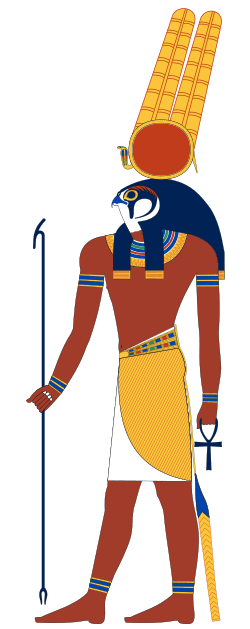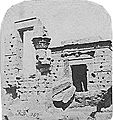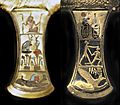Montu facts for kids
Quick facts for kids Montu, Monthu, Mentu or Menthu |
||||
|---|---|---|---|---|
 |
||||
| Name in hieroglyphs |
|
|||
| Major cult center | Hermonthis, Thebes, Medamud, El-Tod | |||
| Symbol | Sun disk, feathers, weapons | |||
| Consort | Raet-Tawy, Tjenenyet, Iunit | |||
Montu was an important god in Ancient Egypt. He was known as a god of war and was often shown as a falcon. The ancient Egyptians believed he represented the strength and power of their pharaohs, especially when they went to battle. Montu was mainly worshipped in Upper Egypt, particularly around the city of Thebes.
Contents
Who Was Montu?
Montu was a powerful god in the religion of ancient Egypt. He was seen as a god of war and strength. People believed he helped the pharaohs win battles. He was often shown with the head of a falcon. Sometimes, he was also shown with the head of a bull. The bull was a symbol of power and fighting spirit.
Montu's Appearance
Montu was usually pictured as a man with the head of a falcon. On his head, he wore a sun disk with two tall feathers. He also carried weapons, like a sword or a bow and arrow. These symbols showed his connection to war and the sun's power. Sometimes, he was even shown as a griffin, a mythical creature that was part lion and part eagle.
Montu and the Pharaohs
Many pharaohs looked up to Montu. They believed he gave them courage and helped them conquer their enemies. Some pharaohs even included Montu's name in their own names. For example, several kings were named Mentuhotep, which means "Montu is pleased." This shows how important Montu was to the rulers of Egypt. He was a symbol of their military might.
Where Was Montu Worshipped?
Montu was worshipped in several cities in ancient Egypt. His main worship centers were in places like Hermonthis (modern-day Armant), Thebes, Medamud, and El-Tod. These cities were in Upper Egypt.
Temples of Montu
Many temples were built to honor Montu. These temples were important places for religious ceremonies. Priests would perform rituals to ask for Montu's blessing in war. The ruins of some of these temples can still be seen today. They show how grand and important these places were in ancient times.
Images for kids
-
Pharaoh Ptolemy IV Philopator (222–204 BC) adoring Montu — in the "Place Of Truth" of Deir el-Medina.
-
A coarse stela representing the warrior-Pharaoh Senusret III (1878–1839 BC) in the presence of Montu. Egyptian Museum, Cairo.
-
Ruins of the Temple of Montu in Armant, published in The Holy Land, Syria, Idumea, Arabia, Egypt, and Nubia — after a watercolour by David Roberts (1849).
See also
 In Spanish: Montu para niños
In Spanish: Montu para niños










